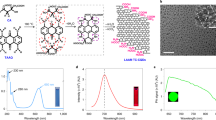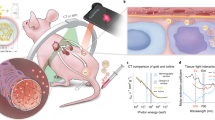Abstract
Single-walled carbon nanotubes (SWNTs) can deliver imaging agents or drugs to tumours and offer significant advantages over approaches based on antibodies or other nanomaterials. In particular, the nanotubes can carry a substantial amount of cargo (100 times more than a monoclonal antibody), but can still be rapidly eliminated from the circulation by renal filtration, like a small molecule, due to their high aspect ratio. Here we show that SWNTs can target tumours in a two-step approach in which nanotubes modified with morpholino oligonucleotide sequences bind to cancer cells that have been pretargeted with antibodies modified with oligonucleotide strands complementary to those on the nanotubes. The nanotubes can carry fluorophores or radioisotopes, and are shown to selectively bind to cancer cells in vitro and in tumour-bearing xenografted mice. The binding process is also found to lead to antigen capping and internalization of the antibody–nanotube complexes. The nanotube conjugates were labelled with both alpha-particle and gamma-ray emitting isotopes, at high specific activities. Conjugates labelled with alpha-particle-generating 225Ac were found to clear rapidly, thus mitigating radioisotope toxicity, and were shown to be therapeutically effective in vivo.
This is a preview of subscription content, access via your institution
Access options
Subscribe to this journal
Receive 12 print issues and online access
$259.00 per year
only $21.58 per issue
Buy this article
- Purchase on Springer Link
- Instant access to full article PDF
Prices may be subject to local taxes which are calculated during checkout






Similar content being viewed by others
References
Scheinberg, D. A., Villa, C. H., Escorcia, F. E. & McDevitt, M. R. Conscripts of the infinite armada: systemic cancer therapy using nanomaterials. Nature Rev. Clin. Oncol. 7, 266–276 (2010).
Davis, M. E., Chen, Z. G. & Shin, D. M. Nanoparticle therapeutics: an emerging treatment modality for cancer. Nature Rev. Drug Discov. 7, 771–782 (2008).
Kostarelos, K., Bianco, A. & Prato, M. Promises, facts and challenges for carbon nanotubes in imaging and therapeutics. Nature Nanotech. 4, 627–633 (2009).
Liu, Z. et al. Drug delivery with carbon nanotubes for in vivo cancer treatment. Cancer Res. 68, 6652–6660 (2008).
Liu, Z. et al. In vivo biodistribution and highly efficient tumour targeting of carbon nanotubes in mice. Nature Nanotech. 2, 47–52 (2007).
Villa, C. H. et al. Single-walled carbon nanotubes deliver peptide antigen into dendritic cells and enhance IgG responses to tumour-associated antigens. ACS Nano. 5, 5300–5311 (2011).
Villa, C. H. et al. Synthesis and biodistribution of oligonucleotide-functionalized, tumour-targetable carbon nanotubes. Nano Lett. 8, 4221–4228 (2008).
McDevitt, M. R. et al. PET imaging of soluble yttrium-86-labeled carbon nanotubes in mice. PLoS ONE 2, e907 (2007).
McDevitt, M. R. et al. Tumour targeting with antibody-functionalized, radiolabeled carbon nanotubes. J. Nucl. Med. 48, 1180–1189 (2007).
Ruggiero, A. et al. Imaging and treating tumour vasculature with targeted radiolabeled carbon nanotubes. Int. J. Nanomed. 5, 783–802 (2010).
Singh, R. et al. Tissue biodistribution and blood clearance rates of intravenously administered carbon nanotube radiotracers. Proc. Natl Acad. Sci. USA 103, 3357–3362 (2006).
Liu, Z. et al. Circulation and long-term fate of functionalized, biocompatible single-walled carbon nanotubes in mice probed by Raman spectroscopy. Proc. Natl Acad. Sci. USA 105, 1410–1415 (2008).
Mutlu, G. K. M. et al. Biocompatible nanoscale dispersion of single-walled carbon nanotubes minimizes in vivo pulmonary toxicity. Nano Lett. 10, 1664–1670 (2010).
Ruggiero, A. et al. Paradoxical glomerular filtration of carbon nanotubes. Proc. Natl Acad. Sci. USA 107, 12369–12374 (2010).
Lacerda, L. et al. Carbon-nanotube shape and individualization critical for renal excretion. Small 4, 1130–1132 (2008).
Kostarelos, K. Carbon nanotubes: fibrillar pharmacology. Nature Mater. 9, 793–795 (2010).
Goldenberg, D., Sharkey, R., Paganelli, G. & Barbet, J. Antibody pretargeting advances cancer radioimmunodetection and radioimmunotherapy. J. Clin. Oncol. 10, 823–834 (2006).
Green, D. J. et al. Pretargeted radioimmunotherapy for B-cell lymphomas. Clin. Cancer Res. 13, 5598s–5603s (2007).
Sharkey, R. M. et al. Improved therapy of non-Hodgkin's lymphoma xenografts using radionuclides pretargeted with a new anti-CD20 bispecific antibody. Leukemia 19, 1064–1069 (2005).
Liu, G. et al. Successful radiotherapy of tumour in pretargeted mice by 188Re-radiolabeled phosphorodiamidate morpholino oligomer, a synthetic DNA analogue. Clin. Cancer. Res. 12, 4958–4964 (2006).
Rossin, R. et al. In vivo chemistry for pretargeted tumour imaging in live mice. Angew. Chem. Int. Ed. 49, 3375–3378 (2010).
Park, J-H. et al. Cooperative nanomaterial system to sensitize, target, and treat tumours. Proc. Natl Acad. Sci. USA 107, 981–986 (2010).
Perrault, S. D. & Chan, W. C. W. In vivo assembly of nanoparticle components to improve targeted cancer imaging. Proc. Natl Acad. Sci. USA 107, 11194–11199 (2010).
Liu, G. et al. Adding a clearing agent to pretargeting does not lower the tumour accumulation of the effector as predicted. Cancer Biother. Radio. 25, 757–762 (2010).
Alvarez-Diez, T. M., Polihronis, J. & Reilly, R. M. Pretargeted tumour imaging with streptavidin immunoconjugates of monoclonal antibody CC49 and 111In-DTPA-biocytin. Nucl. Med. and Biol. 23, 459–466 (1996).
He, J. et al. Affinity enhancement pretargeting: synthesis and testing of a (99m)Tc-labeled bivalent MORF. Mol. Pharmacol. 2, 1118–1124 (2010).
Staii, C., Johnson, A. T., Chen, M. & Gelperin, A. DNA-decorated carbon nanotubes for chemical sensing. Nano Lett. 5, 1774–1778 (2005).
Liu, G. et al. Tumour pretargeting in mice using (99m)Tc-labeled morpholino, a DNA analog. J. Nucl. Med. 43, 384–391 (2002).
Moulton, H. M. et al. Peptide–morpholino conjugate: a promising therapeutic for Duchenne muscular dystrophy. Ann. NY Acad. Sci. 1175, 55–60 (2009).
Park, S. Y. et al. DNA-programmable nanoparticle crystallization. Nature 451, 553–556 (2008).
Hnatowic, D. J. & Nakamura, K. The influence of chemical structure of DNA and other oligomer radiopharmaceuticals on tumour delivery. Curr. Opin. Mol. Ther. 8, 136–143 (2006).
Georgakilas, V. et al. Organic functionalization of carbon nanotubes. J. Am. Chem. Soc. 124, 760–761 (2002).
Georgakilas, V. et al. Amino acid functionalisation of water soluble carbon nanotubes. Chem Commun. 3050–3051 (2002).
McDevitt, M. R. et al. Tumour therapy with targeted atomic nanogenerators. Science 294, 1537–1540 (2001).
He, J. et al. An improved method for covalently conjugating morpholino oligomers to antitumour antibodies. Bioconjug. Chem. 18, 983–988 (2007).
Ackerman, M. E. et al. A33 antigen displays persistent surface expression. Cancer Immunol. Immunother. 57, 1017–1027 (2008).
Welt, S. et al. Phase I study of anticolon cancer humanized antibody A33. Clin. Cancer Res. 9, 1338–1346 (2003).
Golay, J. et al. Biologic response of B lymphoma cells to anti-CD20 monoclonal antibody rituximab in vitro: CD55 and CD59 regulate complement-mediated cell lysis. Blood 95, 3900–3908 (2000).
Miederer, M., Scheinberg, D. & McDevitt, M. Realizing the potential of the actinium-225 radionuclide generator in targeted alpha particle therapy applications. Adv. Drug Deliv. Rev. 60, 1371–1382 (2008).
Song, H. et al. Radioimmunotherapy of breast cancer metastases with alpha-particle emitter 225Ac: comparing efficacy with 213Bi and 90Y. Cancer Res. 69, 8941–8948 (2009).
Miederer, M. et al. Pharmacokinetics, dosimetry, and toxicity of the targetable atomic generator, 225Ac–HuM195, in nonhuman primates. J. Nucl. Med. 45, 129–137 (2004).
Liu, G. & Hnatowich, D. J. A semiempirical model of tumour pretargeting. Bioconjug. Chem. 19, 2095–2104 (2008).
Vegt, E. et al. Renal toxicity of radiolabeled peptides and antibody fragments: mechanisms, impact on radionuclide therapy, and strategies for prevention. J. Nucl. Med. 51, 1049–1058 (2010).
Kaiser, E., Colescott, R. L., Bossinger, C. D. & Cook, P. I. Color test for detection of free terminal amino groups in the solid-phase synthesis of peptides. Anal. Biochem. 34, 595–598 (1970).
Liu, G. et al. Predicting the biodistribution of radiolabeled cMORF effector in MORF-pretargeted mice. Eur. J. Nucl. Med. Mol. I 34, 237–246 (2007).
Acknowledgements
The authors acknowledge support from the National Institutes of Health (NIH P01 CA33049 to D.A.S.; NIH R01 CA55349 to D.A.S.; R21 CA128406 to M.R.M.), the Office of Science (BER), the US Department of Energy (award no. DE-SC0002456 to M.R.M.), the NIH Medical Scientist Training Program (MSTP; grant GM07739 to J.J.M., C.H.V. and F.E.E.), the MSKCC Molecular Cytology Core Facility, the MSKCC Experimental Therapeutics Center, the MSKCC Brain Tumour Center and The Tudor and Glades Funds. The authors thank D. Hnatowich for helpful discussions. The authors also thank W. Maguire, S. Alidori and E. Feinberg for assistance, Actinium Pharmaceuticals for 225Ac acquisition, and M. Bergkvist for TEM and Raman spectroscopy.
Author information
Authors and Affiliations
Contributions
J.J.M., C.V., D.A.S. and M.M. conceived and designed the experiments and wrote the paper. C.V. and J.J.M. conducted all the experiments. E.C. assisted with confocal microscopy experiments. F.E. assisted with solid tumour targeting experiments.
Corresponding author
Ethics declarations
Competing interests
The authors declare no competing financial interests.
Supplementary information
Supplementary information
Supplementary Information (PDF 9490 kb)
Rights and permissions
About this article
Cite this article
Mulvey, J., Villa, C., McDevitt, M. et al. Self-assembly of carbon nanotubes and antibodies on tumours for targeted amplified delivery. Nature Nanotech 8, 763–771 (2013). https://doi.org/10.1038/nnano.2013.190
Received:
Accepted:
Published:
Issue Date:
DOI: https://doi.org/10.1038/nnano.2013.190
This article is cited by
-
In vitro studies of 223Ra- and 225Ac-labelled α-zirconium phosphate as potential carrier for alpha targeted therapy
Journal of Radioanalytical and Nuclear Chemistry (2023)
-
Low dimensional nanomaterials for treating acute kidney injury
Journal of Nanobiotechnology (2022)
-
Fibrillar pharmacology of functionalized nanocellulose
Scientific Reports (2021)
-
Enhancing the Thermal Stability of Carbon Nanomaterials with DNA
Scientific Reports (2019)
-
Deconvoluting hepatic processing of carbon nanotubes
Nature Communications (2016)



